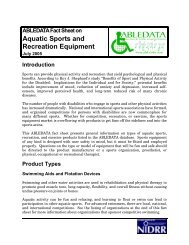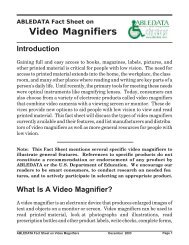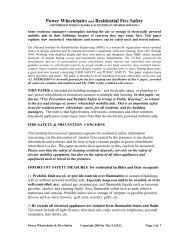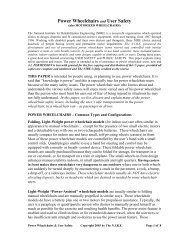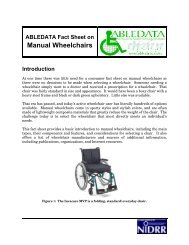Vision Aids for Impaired Peripheral Vision or Tunnel Vision - AbleData
Vision Aids for Impaired Peripheral Vision or Tunnel Vision - AbleData
Vision Aids for Impaired Peripheral Vision or Tunnel Vision - AbleData
You also want an ePaper? Increase the reach of your titles
YUMPU automatically turns print PDFs into web optimized ePapers that Google loves.
FX devices, then the person may retain functionally better visual acuity with the two eyes<br />
than with either eye alone.<br />
Figure 3 – TV-2B Field-Expanding Glasses <strong>f<strong>or</strong></strong> Very Narrow Visual Fields<br />
. . . . Ranging from 2 to 20 degrees, unaided<br />
(FX devices can be mounted low- <strong>or</strong> high – but both should be the similarly mounted)<br />
FX Choices include: (1) Maximum Diameter of Faceplate: this always depends on the<br />
user’s unaided visual field width. The faceplate should be the widest diameter possible<br />
with the eye being able to see all of the faceplate at the same time without scanning. A<br />
person having an unaided field width of 20 degrees needs a wider Faceplate Diameter<br />
than a person having an unaided field width of only 2 degrees. (2) Optical Field Width of<br />
Surroundings to be Displayed reduced on faceplate … and (3) Linearity of Image. The<br />
angle can be set to any of these values: 120, 110, 90, 70 <strong>or</strong> 50 degrees. Linearity is<br />
chosen to be either “Linear” <strong>or</strong> “Non-Linear.” These choices are further detailed below<br />
<strong>f<strong>or</strong></strong> each of the “Optics Design Categ<strong>or</strong>ies.” Recommendation: Likely progression of<br />
the field losses should be taken into account when purchasing FX eyeglasses. An RP<br />
patient, may be better off using a design <strong>f<strong>or</strong></strong> under 10 degrees, <strong>f<strong>or</strong></strong> example, if his unaided<br />
visual field widths are 10 to 15 degrees when the glasses are <strong>or</strong>dered.<br />
POSSIBLE DESIGNS <strong>f<strong>or</strong></strong> …<br />
People with Unaided Visual Field Widths: 2 to 10 degrees - with GOOD acuity<br />
Good visual acuity: Most patients in this categ<strong>or</strong>y – after trying both types of field<br />
expanders (Linear and Non-Linear) – chose the Non-Linear FX types in <strong>or</strong>der to have the<br />
widest possible expanded visual fields. They mostly chose to have the tubular FX<br />
devices mounted high (right lens as shown in Fig. 3) on both lenses. The mountings were<br />
at the users’ PDs <strong>or</strong> pupillary distances, with exactly parallel mountings. The significant<br />
10 <strong>Tunnel</strong> <strong>Vision</strong> Copyright 2003 by The N.I.R.E. Page 10 of 13



